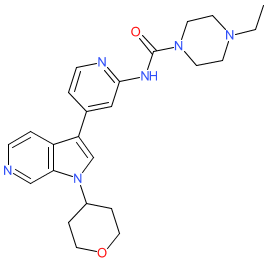GtoPdb is requesting financial support from commercial users. Please see our sustainability page for more information.
|
Synonyms: compound 13g [PMID: 32077280] | GNF-2133
Compound class:
Synthetic organic
Comment: GNF2133 is a potent, selective and orally bioavailable inhibitor of dual specificity tyrosine phosphorylation regulated kinase 1A (DYRK1A) [3]. It was designed and reported by the Genomics Institute of the Novartis Research Foundation (GNF). Inhibition of DYRK1A is being examined as a mechanism to promote β-cell proliferation as a novel therapy for type I diabetes. GNF2133 is active in relevant in vivo models. Significantly, GNF2133 is devoid of glycogen synthase kinase-3β (GSK3β) inhibitory activity, which is considered to be a potential long-term treatment liability of pre-exisitng dual DYRK1A/GSK3β inhibitors [1].
See also compound 2-2c [PMID: 32003560], which is a selective DYRK1A inhibitor with a different chemical scaffold [2]. Ligand Activity Visualisation ChartsThese are box plot that provide a unique visualisation, summarising all the activity data for a ligand taken from ChEMBL and GtoPdb across multiple targets and species. Click on a plot to see the median, interquartile range, low and high data points. A value of zero indicates that no data are available. A separate chart is created for each target, and where possible the algorithm tries to merge ChEMBL and GtoPdb targets by matching them on name and UniProt accession, for each available species. However, please note that inconsistency in naming of targets may lead to data for the same target being reported across multiple charts. ✖ |
|
|||||||||||||||||||||||||||||||||||
| Bioactivity Comments |
| GNF2133 does not inhibit hERG [3]. IInhibition of GSK3β was negligible (IC50>50 μM). In a cellular kinase selectivity screening panel the higher dose (2 μM) of GNF2133 inhibited (in addition to DYRK1A) DYRK1B and DYRK2, RIPK2, FLT4 and CLK1/2/4. GNF2133 promotes proliferation of human and mouse β-cells in vitro and rat β-cells in vivo. The in vivo effect on β-cells was accompanied by elevated insulin production and improved glycemic control was detected in a mouse diabetes model. However, hypertrophic effects in nonpancreatic tissues and renal toxicity were observed in rats treated with GNF2133 for 14 days [3], so these issues need to be addressed before a GNF2133-based strategy is ready for further advancement. |
| Selectivity at enzymes | ||||||||||||||||||||||||||||||||||
| Key to terms and symbols | Click column headers to sort | |||||||||||||||||||||||||||||||||
|
||||||||||||||||||||||||||||||||||







